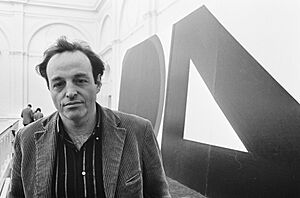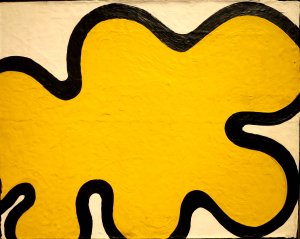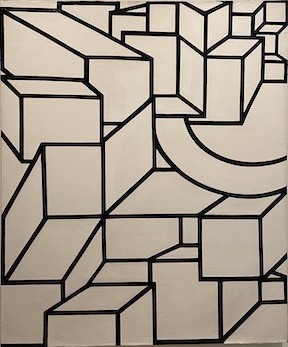Al Held facts for kids
Quick facts for kids
Al Held
|
|
|---|---|

Al Held at the Stedelijk Museum in Amsterdam in 1966
|
|
| Born | October 12, 1928 |
| Died | July 27, 2005 (aged 76) near Todi, Italy
|
| Education | Art Students League of New York, Académie de la Grande Chaumière |
| Style | Geometric abstraction Hard-edge painting |
| Movement | Abstract expressionism |
| Spouse(s) | Sylvia Stone Yvonne Rainer Giselle Wexler Kathleen Monaghan |
| Awards | Logan Medal of the Arts |
Al Held (born October 12, 1928 – died July 27, 2005) was an American painter. He was famous for his large and colorful abstract artworks. Throughout his career, Al Held changed his painting style many times. In the 1950s, his art looked like Abstract expressionism. Later, in the 1960s, he moved to a geometric style. By the 1980s, his paintings showed bright shapes that seemed to go on forever. He also taught art at Yale University from 1963 to 1980.
Contents
Early Life and Learning
Al Held was born in Brooklyn, New York in 1928. He grew up in the East Bronx. His family faced tough times during the Great Depression.
He didn't show interest in art until after serving in the Navy in 1947. A friend named Nicholas Krushenick inspired him. Al Held then joined the Art Students League of New York. He first thought about studying with a famous muralist (a painter who creates large wall paintings) in Mexico. But his plans didn't work out.
In 1951, he used money from the G.I. Bill to go to Paris. He studied there for two years at the Académie de la Grande Chaumière. In Paris, he decided that realistic painting was not for him. He started to focus on abstract art. Back then, new artists in the United States were inspired by abstract expressionists. Painters like Jackson Pollock and Mark Rothko influenced Al Held. He returned to New York in 1953.
Art Career
Al Held had his first art show in Paris in 1952. But the art world in New York was becoming very exciting. So, Held moved back there. In 1959, he had a solo show in New York. His large, colorful paintings of simple abstract geometric shapes became well-known. People in America and Europe started to notice his work.
In 1962, he became a professor at the Yale School of Art. He taught there until 1980. In 1965, an art critic named Irving Sandler put together a show. It was called Concrete Expressionism. This show featured Al Held's work.
Al Held received the Logan Medal of the Arts in 1964. He also got a Guggenheim Fellowship in 1966. By 1967, he felt he had explored his current style enough. He then started painting in black and white. These new works played with tricky perspectives. Some people found them confusing. Others thought they were his best work yet. By the late 1970s, he began using color in his art again.
In his later years, Held created very large paintings for buildings. In 2005, he finished a huge, colorful mural for the New York City Subway. It is at the Lexington Avenue / 51st – 53rd Streets station. Three of his murals were also in the original WTC 7 building.
Al Held passed away in Italy in 2005 at age 76.
His Art Styles
Al Held explored many different styles during his career.
Pigment Paintings
In his early pigment paintings, Al Held used thick brush strokes. These strokes went in many directions. This style is called action painting. He often used muted, earthy colors. These paintings usually had no clear foreground or background. Sometimes, paint drips were splashed on the canvas.
As the 1950s went on, Held started to make longer strokes. He combined them into shapes like triangles and circles. This hinted at the geometric abstraction style he would use later.
Hard-Edge Paintings

By the late 1950s, Al Held became less interested in gestural painting. He felt that this style had become too common. By 1960, he found a new way to paint. This style was called Hard-edge painting. It is also known as post-painterly abstraction or cool art.
For these paintings, Held switched from oil paint to water-based acrylics. His hard-edge paintings used bright colors. They featured geometric shapes placed all over the canvas. These artworks were nonobjective. This means they didn't show real people, places, or things. An example is Untitled from 1964, which is at the Honolulu Museum of Art.
Alphabet Paintings
Around 1961-1966, Al Held created very large abstract letters. These were letters from the English alphabet. He titled these paintings things like The Big ‘N' or The Big ‘X’. Held played with how viewers saw these letters. He made the letters seem to lean forward and backward at the same time. This made people think about space and how shapes look in different dimensions.
Geometric Abstraction
In 1967, Held felt limited by the flat look of his earlier hard-edge paintings. He wanted to create more depth in his art. He decided to make shapes look three-dimensional on the canvas. Works like Giza Gate II and Flemish IV show this style well. A large black-and-white mural called Rothko's Canvas was made for The Governor Nelson A. Rockefeller Empire State Plaza Art Collection in Albany, NY.

These works were all made with black and white acrylic paint. They show zigzagging, cube-like shapes. Even though they had similar content, each painting had a unique design. Grid-like elements started to appear more often. These looked like the framework of buildings. The paintings could be confusing because their patterns were not centered. It was hard to find a clear viewpoint.
As his art became more complex, it was less often called minimalism. The size of these works was also remarkable. For example, in 1976, he painted two huge murals in Philadelphia. They were called Order/Disorder and Ascension/Descension. Each mural was 13 by 90 feet. They stretched across an office building.
The Pérez Art Museum Miami has an example of Held's geometric abstraction series. It is titled Solar Wind I, made between 1973-74.
Watercolors
In the 1980s, Al Held created many watercolor paintings in Rome. The way he drew the shapes made them seem to go deep into the canvas. These works challenged the imagination. They had shapes that intersected and varied in size. Held's idea of infinity in these works made viewers think deeply. Paintings like Pachinko made people wonder how huge the structures were. The shapes could be large and far away, or small and close up. This challenged how people saw space around them.
Contemporary Works
Many of Al Held's later artworks featured large, balanced, non-objective shapes. He used bright colors and acrylic paint. He created interlocking structures that looked like architecture. The old buildings of Rome and the idea of the renaissance inspired him. He brought these ideas back to New York. His art had architectural qualities. But the colored planes were not meant to represent anything real.
In 1983, his 15 by 55-foot mural Mantegna’s Edge was finished in Dallas, Texas. This work was less broken up than some of his others. It had a deeper sense of order. Bright, grid-like shapes existed in a huge blue space. Yet, it also had a feeling of mystery and complexity.
Personal Life
Al Held had a daughter named Mara. He later married sculptor Sylvia Stone. He also married art historian Kathleen Monaghan.
See also

